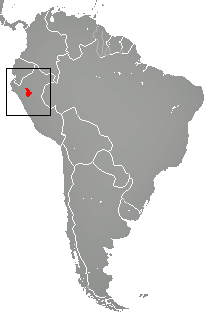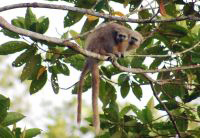Navigation
Endangered Monkey Survives in Tiny Private Paradise in Peru
A conservation area covering a mere 23.5 hectares has become a refuge for a unique and endangered animal species in the northeastern Peruvian region of San Martín: the Andean titi monkey.
|
A conservation area covering a mere 23.5 hectares has become a refuge for a unique and endangered animal species in the northeastern Peruvian region of San Martín: the Andean titi monkey. This wilderness preserve was created by a local woman who singlehandedly set out to re-establish a small area of native forest.
The early morning silence of the forest is suddenly broken by what sounds like the cries of warriors. Some come from the north, others from the south, then from the west and the east. This is the sound of ten families of Andean titi monkeys, Callicebus oenanthe, also known as the Río Mayo or San Martín titi monkey, marking their territory. Each family comprises four members: a mother, father and two offspring.
"Each one cries at a different time, but all between 6:00 and 7:30 in the morning," explained Josie Chambers, a young biologist from the United States, who enthusiastically shared video footage and photographs of the endangered primates with Tierramérica.
The monkeys are around 30 centimeters long and their fur is a mix of brownish grey and orange. Some stare with open curiosity at the camera, others hide and make warning sounds. They have survived thanks to the refuge provided the Pucunucho private conservation area, located in the province of Mariscal Cáceres in the region of San Martín.
San Martín is one of the three most deforested regions in the Peruvian Amazon. To confront this problem, civil society organizations and local residents joined together and pressured the government to grant them four conservation areas, encompassing a total of 267,133 hectares, under the Forest and Wildlife Law of 2000.
Pucunucho forms part of this network of conservation areas aimed at preserving or restoring biodiversity.
"It’s amazing that a young forest like Pucunucho, which was just restored in the last 16 years, could be a refuge for an endangered species," said Chambers, 21, who has already had the opportunity to work with red colobus monkeys in Uganda and white-faced capuchin monkeys in Costa Rica.
Andean titi monkeys can only live at altitudes of up to 1,000 meters above sea level, and it is in lowland areas like these that forests have become scarcest, due to the advance of agriculture, cattle farming and urbanization. Pucunucho, for example, is just a 10-minute drive from the city of Juanjuí, the capital of Mariscal Cáceres.
"Their habitat needs to be expanded so they don’t remain isolated. Otherwise, in 30 or 40 years, they will die off from a lack of genetic exchange," stressed Chambers.
 |
| Rio Mayo Titi,Callicebus oenanthe, range. Distribution data from IUCN Red List |
Proyecto Mono Tocón (the Andean Titi Monkey Project) hopes to create a 180-hectare corridor to provide a larger area for the monkeys to live in. To achieve this goal, they will need the cooperation of neighboring landowners, who would have to allow part of their property to be used for the initiative.
The corridor would be located along the sides of the Pucunucho River basin, which branches off from between the basins of the Huallaga and Huallabamba Rivers.
"Yes, I would be willing to help take care of the little monkeys," 70-year-old Pucunucho area landowner Isaías Moreno told Tierramérica. He wants to follow in the footsteps of Trinidad Vela, a local woman now 74 years old, who began to rescue this forest area in 1994 by planting native tree species.
Vela’s daughter, biologist Karina Pinasco, proudly described to Tierramérica the intelligent way in which her mother went about this task. "She started out by planting legume crops to restore the soil, and then planted ice cream bean trees, Inga sp., aguaje palms, Mauritia flexuosa, moenas, Aniba gigantiflora, and mahogany trees, all arranged haphazardly, like in a natural forest."
The crusade spearheaded by Vela contributed to the recovery of the flow of the Pucunucho River, which had dried out. In 2005, the river’s water saved local farmers from the potentially disastrous effects of a severe drought. Now her efforts have helped rescue the Andean titi monkeys, which feed mainly on ice cream bean trees and fruit, from falling into extinction.
"When I started to bring back the forest, I never imagined it would become a habitat for so much wildlife," Vela told Tierramérica.
But threats still loom over the conservation area, including local residents who hunt monkeys for food, and development projects that disregard potential environmental impacts.
In April 2010, state-owned power company Electro Oriente deforested part of the area to install a high-voltage electrical pylon, without requesting permission. Pinasco carried out an assessment of the consequent losses in flora and fauna, which came to 117,357 US dollars.
The company’s actions were reported immediately to the regional environmental authority, which recently informed Pinasco that they were not deemed an environmental infraction.
Pucunucho is home to a wealth of species. The team of biologists that studied the Andean titi monkeys also identified bird species such as the dusky-legged guan, Penelope obscura, toucan, hummingbird and hoatzin, Opisthocomus hoazin, considered a missing link with prehistoric birds, a sort of feathered reptile.
"Peru is a mega-diverse country that gives rise to unique species in this transition between the rainforest and the Andes (mountain range). There is a great deal to study here," Spanish biologist César Aguilar told Tierramérica.
Aguilar and Chambers were brought to San Martín by Neotropical Primate Conservation, a non-governmental, non-profit conservationist Organisation based in the United Kingdom. Here they joined up with a group of young environmental engineers from the region who have been involved in efforts to rescue the Andean titi monkey since 2007, including Sergio Rodríguez.
"What I found particularly interesting was the way they organize into groups, and the fact that, unlike other primates, it is the male who carries the young, not the mother," said Rodríguez, a member of Proyecto Mono Tocón.
According to the group’s research, the species is found in the environs of the Upper and Lower Mayo River and as far as the central Huallaga River, an area totaling 8,640 kilometers.
"We would like to set up a tour so that our people can discover what we have here," said Renán Saavedra, head of the provincial government of Mariscal Cáceres, who visited Pucunucho early one April morning and heard the monkeys’ warrior cries for himself.
This article is from and courtesy of IPS News at http://www.ipsnews.net/ 16 April 2011.
This story was originally published by Latin American newspapers that are part of the Tierramérica network. Tierramérica is a specialised news service produced by IPS with the backing of the United Nations Development Programme, United Nations Environment Programme and the World Bank. Author: Milagros Salazar - Tierramérica
Search
Latest articles
Agriculture
- World Water Week: Healthy ecosystems essential to human health: from coronavirus to malnutrition Online session Wednesday 24 August 17:00-18:20
- World Water Week: Healthy ecosystems essential to human health: from coronavirus to malnutrition Online session Wednesday 24 August 17:00-18:20
Air Pollution
- "Water and Sanitation-Related Diseases and the Changing Environment: Challenges, Interventions, and Preventive Measures" Volume 2 Is Now Available
- Global Innovation Exchange Co-Created by Horizon International, USAID, Bill and Melinda Gates Foundation and Others
Biodiversity
- It is time for international mobilization against climate change
- World Water Week: Healthy ecosystems essential to human health: from coronavirus to malnutrition Online session Wednesday 24 August 17:00-18:20
Desertification
- World Water Week: Healthy ecosystems essential to human health: from coronavirus to malnutrition Online session Wednesday 24 August 17:00-18:20
- UN Food Systems Summit Receives Over 1,200 Ideas to Help Meet Sustainable Development Goals
Endangered Species
- Mangrove Action Project Collaborates to Restore and Preserve Mangrove Ecosystems
- Coral Research in Palau offers a “Glimmer of Hope”
Energy
- Global Innovation Exchange Co-Created by Horizon International, USAID, Bill and Melinda Gates Foundation and Others
- Wildlife Preservation in Southeast Nova Scotia
Exhibits
- Global Innovation Exchange Co-Created by Horizon International, USAID, Bill and Melinda Gates Foundation and Others
- Coral Reefs
Forests
- NASA Satellites Reveal Major Shifts in Global Freshwater Updated June 2020
- Global Innovation Exchange Co-Created by Horizon International, USAID, Bill and Melinda Gates Foundation and Others
Global Climate Change
- It is time for international mobilization against climate change
- It is time for international mobilization against climate change
Global Health
- World Water Week: Healthy ecosystems essential to human health: from coronavirus to malnutrition Online session Wednesday 24 August 17:00-18:20
- More than 400 schoolgirls, family and teachers rescued from Afghanistan by small coalition
Industry
- "Water and Sanitation-Related Diseases and the Changing Environment: Challenges, Interventions, and Preventive Measures" Volume 2 Is Now Available
- Global Innovation Exchange Co-Created by Horizon International, USAID, Bill and Melinda Gates Foundation and Others
Natural Disaster Relief
- STOP ATTACKS ON HEALTH CARE IN UKRAINE
- Global Innovation Exchange Co-Created by Horizon International, USAID, Bill and Melinda Gates Foundation and Others
News and Special Reports
- World Water Week: Healthy ecosystems essential to human health: from coronavirus to malnutrition Online session Wednesday 24 August 17:00-18:20
- STOP ATTACKS ON HEALTH CARE IN UKRAINE
Oceans, Coral Reefs
- World Water Week: Healthy ecosystems essential to human health: from coronavirus to malnutrition Online session Wednesday 24 August 17:00-18:20
- Mangrove Action Project Collaborates to Restore and Preserve Mangrove Ecosystems
Pollution
- Zakaria Ouedraogo of Burkina Faso Produces Film “Nzoue Fiyen: Water Not Drinkable”
- "Water and Sanitation-Related Diseases and the Changing Environment: Challenges, Interventions, and Preventive Measures" Volume 2 Is Now Available
Population
- "Water and Sanitation-Related Diseases and the Changing Environment: Challenges, Interventions, and Preventive Measures" Volume 2 Is Now Available
- "Water and Sanitation-Related Diseases and the Changing Environment: Challenges, Interventions, and Preventive Measures" Volume 2 Is Now Available
Public Health
- Honouring the visionary behind India’s sanitation revolution
- Honouring the visionary behind India’s sanitation revolution
Rivers
- World Water Week: Healthy ecosystems essential to human health: from coronavirus to malnutrition Online session Wednesday 24 August 17:00-18:20
- Mangrove Action Project Collaborates to Restore and Preserve Mangrove Ecosystems
Sanitation
- Honouring the visionary behind India’s sanitation revolution
- Honouring the visionary behind India’s sanitation revolution
Toxic Chemicals
- "Water and Sanitation-Related Diseases and the Changing Environment: Challenges, Interventions, and Preventive Measures" Volume 2 Is Now Available
- Actions to Prevent Polluted Drinking Water in the United States
Transportation
- "Water and Sanitation-Related Diseases and the Changing Environment: Challenges, Interventions, and Preventive Measures" Volume 2 Is Now Available
- Urbanization Provides Opportunities for Transition to a Green Economy, Says New Report
Waste Management
- Honouring the visionary behind India’s sanitation revolution
- Honouring the visionary behind India’s sanitation revolution
Water
- Honouring the visionary behind India’s sanitation revolution
- Honouring the visionary behind India’s sanitation revolution
Water and Sanitation
- Honouring the visionary behind India’s sanitation revolution
- Honouring the visionary behind India’s sanitation revolution


